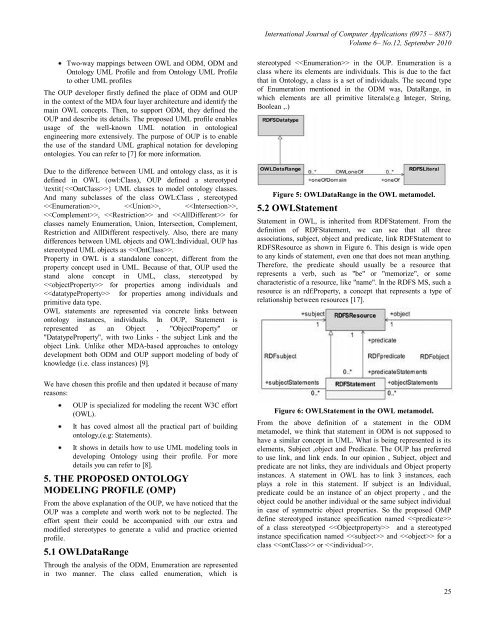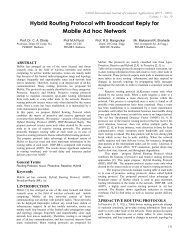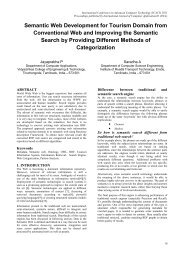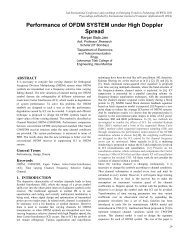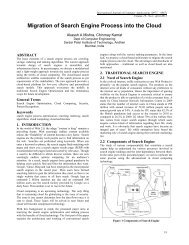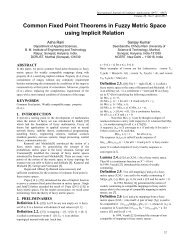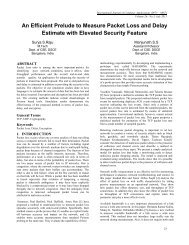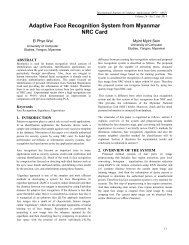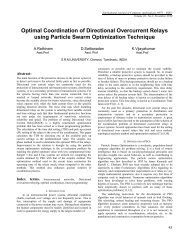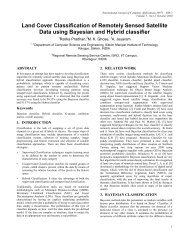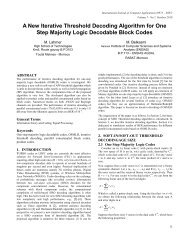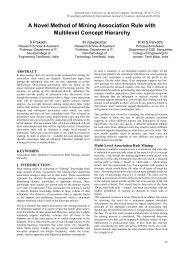Ontology Modeling Profile, an Extension for the ... - ResearchGate
Ontology Modeling Profile, an Extension for the ... - ResearchGate
Ontology Modeling Profile, an Extension for the ... - ResearchGate
Create successful ePaper yourself
Turn your PDF publications into a flip-book with our unique Google optimized e-Paper software.
International Journal of Computer Applications (0975 – 8887)<br />
Volume 6– No.12, September 2010<br />
Two-way mappings between OWL <strong>an</strong>d ODM, ODM <strong>an</strong>d<br />
<strong>Ontology</strong> UML <strong>Profile</strong> <strong>an</strong>d from <strong>Ontology</strong> UML <strong>Profile</strong><br />
to o<strong>the</strong>r UML profiles<br />
The OUP developer firstly defined <strong>the</strong> place of ODM <strong>an</strong>d OUP<br />
in <strong>the</strong> context of <strong>the</strong> MDA four layer architecture <strong>an</strong>d identify <strong>the</strong><br />
main OWL concepts. Then, to support ODM, <strong>the</strong>y defined <strong>the</strong><br />
OUP <strong>an</strong>d describe its details. The proposed UML profile enables<br />
usage of <strong>the</strong> well-known UML notation in ontological<br />
engineering more extensively. The purpose of OUP is to enable<br />
<strong>the</strong> use of <strong>the</strong> st<strong>an</strong>dard UML graphical notation <strong>for</strong> developing<br />
ontologies. You c<strong>an</strong> refer to [7] <strong>for</strong> more in<strong>for</strong>mation.<br />
Due to <strong>the</strong> difference between UML <strong>an</strong>d ontology class, as it is<br />
defined in OWL (owl:Class), OUP defined a stereotyped<br />
\textit{} UML classes to model ontology classes.<br />
And m<strong>an</strong>y subclasses of <strong>the</strong> class OWL:Class , stereotyped<br />
, , ,<br />
, <strong>an</strong>d <strong>for</strong><br />
classes namely Enumeration, Union, Intersection, Complement,<br />
Restriction <strong>an</strong>d AllDifferent respectively. Also, <strong>the</strong>re are m<strong>an</strong>y<br />
differences between UML objects <strong>an</strong>d OWL:Individual, OUP has<br />
stereotyped UML objects as .<br />
Property in OWL is a st<strong>an</strong>dalone concept, different from <strong>the</strong><br />
property concept used in UML. Because of that, OUP used <strong>the</strong><br />
st<strong>an</strong>d alone concept in UML, class, stereotyped by<br />
<strong>for</strong> properties among individuals <strong>an</strong>d<br />
<strong>for</strong> properties among individuals <strong>an</strong>d<br />
primitive data type.<br />
OWL statements are represented via concrete links between<br />
ontology inst<strong>an</strong>ces, individuals. In OUP, Statement is<br />
represented as <strong>an</strong> Object , "ObjectProperty" or<br />
"DatatypeProperty", with two Links - <strong>the</strong> subject Link <strong>an</strong>d <strong>the</strong><br />
object Link. Unlike o<strong>the</strong>r MDA-based approaches to ontology<br />
development both ODM <strong>an</strong>d OUP support modeling of body of<br />
knowledge (i.e. class inst<strong>an</strong>ces) [9].<br />
We have chosen this profile <strong>an</strong>d <strong>the</strong>n updated it because of m<strong>an</strong>y<br />
reasons:<br />
OUP is specialized <strong>for</strong> modeling <strong>the</strong> recent W3C ef<strong>for</strong>t<br />
(OWL).<br />
It has coved almost all <strong>the</strong> practical part of building<br />
ontology,(e.g: Statements).<br />
It shows in details how to use UML modeling tools in<br />
developing <strong>Ontology</strong> using <strong>the</strong>ir profile. For more<br />
details you c<strong>an</strong> refer to [8].<br />
5. THE PROPOSED ONTOLOGY<br />
MODELING PROFILE (OMP)<br />
From <strong>the</strong> above expl<strong>an</strong>ation of <strong>the</strong> OUP, we have noticed that <strong>the</strong><br />
OUP was a complete <strong>an</strong>d worth work not to be neglected. The<br />
ef<strong>for</strong>t spent <strong>the</strong>ir could be accomp<strong>an</strong>ied with our extra <strong>an</strong>d<br />
modified stereotypes to generate a valid <strong>an</strong>d practice oriented<br />
profile.<br />
5.1 OWLDataR<strong>an</strong>ge<br />
Through <strong>the</strong> <strong>an</strong>alysis of <strong>the</strong> ODM, Enumeration are represented<br />
in two m<strong>an</strong>ner. The class called enumeration, which is<br />
stereotyped in <strong>the</strong> OUP. Enumeration is a<br />
class where its elements are individuals. This is due to <strong>the</strong> fact<br />
that in <strong>Ontology</strong>, a class is a set of individuals. The second type<br />
of Enumeration mentioned in <strong>the</strong> ODM was, DataR<strong>an</strong>ge, in<br />
which elements are all primitive literals(e.g Integer, String,<br />
Boole<strong>an</strong> ,.)<br />
Figure 5: OWLDataR<strong>an</strong>ge in <strong>the</strong> OWL metamodel.<br />
5.2 OWLStatement<br />
Statement in OWL, is inherited from RDFStatement. From <strong>the</strong><br />
definition of RDFStatement, we c<strong>an</strong> see that all three<br />
associations, subject, object <strong>an</strong>d predicate, link RDFStatement to<br />
RDFSResource as shown in Figure 6. This design is wide open<br />
to <strong>an</strong>y kinds of statement, even one that does not me<strong>an</strong> <strong>an</strong>ything.<br />
There<strong>for</strong>e, <strong>the</strong> predicate should usually be a resource that<br />
represents a verb, such as "be" or "memorize", or some<br />
characteristic of a resource, like "name". In <strong>the</strong> RDFS MS, such a<br />
resource is <strong>an</strong> rdf:Property, a concept that represents a type of<br />
relationship between resources [17].<br />
Figure 6: OWLStatement in <strong>the</strong> OWL metamodel.<br />
From <strong>the</strong> above definition of a statement in <strong>the</strong> ODM<br />
metamodel, we think that statement in ODM is not supposed to<br />
have a similar concept in UML. What is being represented is its<br />
elements, Subject ,object <strong>an</strong>d Predicate. The OUP has preferred<br />
to use link, <strong>an</strong>d link ends. In our opinion , Subject, object <strong>an</strong>d<br />
predicate are not links, <strong>the</strong>y are individuals <strong>an</strong>d Object property<br />
inst<strong>an</strong>ces. A statement in OWL has to link 3 inst<strong>an</strong>ces, each<br />
plays a role in this statement. If subject is <strong>an</strong> Individual,<br />
predicate could be <strong>an</strong> inst<strong>an</strong>ce of <strong>an</strong> object property , <strong>an</strong>d <strong>the</strong><br />
object could be <strong>an</strong>o<strong>the</strong>r individual or <strong>the</strong> same subject individual<br />
in case of symmetric object properties. So <strong>the</strong> proposed OMP<br />
define stereotyped inst<strong>an</strong>ce specification named <br />
of a class stereotyped <strong>an</strong>d a stereotyped<br />
inst<strong>an</strong>ce specification named <strong>an</strong>d <strong>for</strong> a<br />
class or .<br />
25


